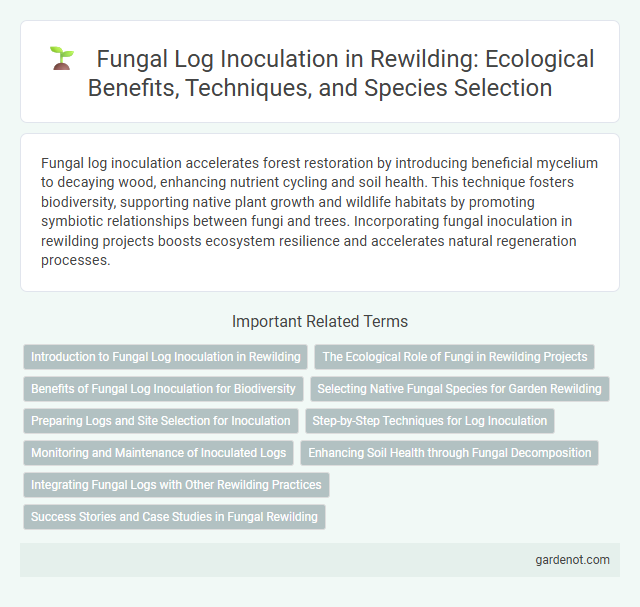Fungal log inoculation accelerates forest restoration by introducing beneficial mycelium to decaying wood, enhancing nutrient cycling and soil health. This technique fosters biodiversity, supporting native plant growth and wildlife habitats by promoting symbiotic relationships between fungi and trees. Incorporating fungal inoculation in rewilding projects boosts ecosystem resilience and accelerates natural regeneration processes.
Introduction to Fungal Log Inoculation in Rewilding
Fungal log inoculation is a critical practice in rewilding that involves introducing beneficial mushroom spores into hardwood logs to restore forest ecosystems. This technique promotes biodiversity by enhancing soil health, accelerating nutrient cycling, and supporting native wildlife habitats through decomposer fungi activity. By mimicking natural fungal processes, fungal log inoculation fosters resilient, self-sustaining ecosystems essential for successful rewilding efforts.
The Ecological Role of Fungi in Rewilding Projects
Fungal log inoculation accelerates forest ecosystem restoration by reintroducing key mycorrhizal fungi that enhance soil nutrient cycling and promote tree health in rewilding projects. These symbiotic fungi decompose organic matter, improve soil structure, and facilitate plant-microbe interactions critical for habitat resilience. Restoring fungal diversity supports biodiversity, carbon sequestration, and long-term ecosystem stability in degraded landscapes.
Benefits of Fungal Log Inoculation for Biodiversity
Fungal log inoculation significantly enhances biodiversity by introducing diverse mycorrhizal fungi that improve soil health and nutrient cycling. These fungi form symbiotic relationships with plants, boosting tree growth and fostering a complex, resilient ecosystem. Increased fungal diversity supports habitat restoration and promotes the return of various fauna, contributing to overall ecosystem stability.
Selecting Native Fungal Species for Garden Rewilding
Selecting native fungal species for fungal log inoculation enhances garden rewilding by promoting local biodiversity and ecosystem resilience. These fungi form symbiotic relationships with indigenous plants, improving soil health and nutrient cycling. Using native fungi ensures better adaptation to the local environment, accelerating habitat restoration and supporting native wildlife.
Preparing Logs and Site Selection for Inoculation
Preparing logs for fungal log inoculation involves selecting freshly cut hardwood, ideally within two weeks of cutting to maximize fungal colonization. Site selection for inoculation requires a shaded, moist area with adequate airflow to prevent excessive drying while minimizing contamination risks. Proper placement ensures optimal mycelium growth, crucial for successful mushroom cultivation and ecosystem restoration.
Step-by-Step Techniques for Log Inoculation
Fungal log inoculation involves drilling evenly spaced holes into freshly cut hardwood logs, typically oak or maple, to introduce spawn of mushroom species like shiitake or maitake. After inserting spawn dowels or sawdust spawn into the holes, sealing each hole with wax prevents contamination and retains moisture essential for mycelial growth. Logs are then stacked in shaded, humid environments and periodically hydrated to optimize fungal colonization and fruiting over several months to years.
Monitoring and Maintenance of Inoculated Logs
Monitoring and maintenance of fungal log inoculation involve regular inspection for mycelial growth, moisture levels, and signs of contamination to ensure optimal colonization. Maintaining consistent environmental conditions, such as humidity and shade, is crucial for healthy fungal development and successful rewilding outcomes. Periodic assessment of decay stages and fungal fruiting bodies helps gauge ecosystem restoration progress and informs adaptive management strategies.
Enhancing Soil Health through Fungal Decomposition
Fungal log inoculation accelerates the decomposition of organic matter, enriching soil with vital nutrients such as nitrogen, phosphorus, and potassium. This process improves soil structure by increasing microbial diversity and promoting the formation of humus, which enhances moisture retention and aeration. Enhanced soil health through fungal activity supports plant growth and restores ecosystem functions in rewilding projects.
Integrating Fungal Logs with Other Rewilding Practices
Fungal log inoculation enhances soil health and biodiversity by introducing mycelium networks that improve nutrient cycling and plant growth. Integrating fungal logs with rewilding practices such as native tree planting and habitat restoration creates symbiotic relationships that accelerate ecosystem recovery. This synergy supports wildlife habitats and promotes resilient, self-sustaining landscapes.
Success Stories and Case Studies in Fungal Rewilding
Fungal log inoculation has proven effective in rewilding projects, with notable success stories such as the restoration of degraded forests in the Pacific Northwest, where mycelium networks have enhanced soil health and biodiversity. Case studies from the UK reveal increased mushroom colonization rates and improved nutrient cycling following inoculation, aiding habitat recovery. These examples demonstrate the critical role of targeted fungal species in accelerating ecosystem restoration and promoting resilient, self-sustaining environments.
Fungal log inoculation Infographic

 gardenot.com
gardenot.com